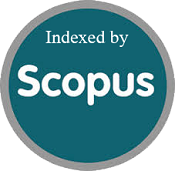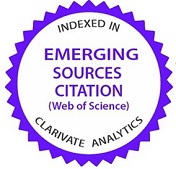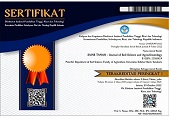Brunauer-Emmett-Teller, Fourier-transform infrared, and scanning-electron-microscope analysis of biochar from marine organic waste
Abstract
Keywords
Full Text:
PDFReferences
Ambroz, F., Macdonald, T. J., Martis, V., & Parkin, I. P. (2018). Evaluation of the BET Theory for the Characterization of Meso and Microporous MOFs. Small Methods, 2(11), 1800173. https://doi.org/10.1002/smtd.201800173
Andriansyah, I., Wijaya, H. N. M., & Purwaniati, P. (2021). Analisis Adulteran Pada Kopi Luwak dengan Metode Fourier Transform Infrared (FTIR) [Analysis of Adulterants in Luwak Coffee by Fourier Transform Infrared (FTIR) Method]. Jurnal Kimia Riset, 6(1), 26-38. https://doi.org/10.20473/jkr.v6i1.23397
Apriliansyah, A., Purnama, D., Johan, Y., & Renta, P. P. (2018). Analisis Parameter Oseanografi dan Lingkungan Ekowisata Pantai di Pantai Panjang Kota Bengkulu [Analysis of oceanographic and ecotourism environmental parameters on Panjang Beach, Bengkulu City]. JURNAL ENGGANO, 3(2), 211-227. https://doi.org/10.31186/jenggano.3.2.211-227
Chen, B., Chen, Z., & Lv, S. (2011). A novel magnetic biochar efficiently sorbs organic pollutants and phosphate. Bioresource Technology, 102(2), 716-723. https://doi.org/10.1016/j.biortech.2010.08.067
Conte, P. (2014). Biochar, soil fertility, and environment. Biology and Fertility of Soils, 50(8), 1175-1175. https://doi.org/10.1007/s00374-014-0973-0
Ding, Y., Liu, Y., Liu, S., Li, Z., Tan, X., Huang, X., . . . Zheng, B. (2016). Biochar to improve soil fertility. A review. Agronomy for Sustainable Development, 36(2), 36. https://doi.org/10.1007/s13593-016-0372-z
Djaguna, A., Pelle, W. E., Schaduw, J. N. W., Manengkey, H. W. K., Rumampuk, N. D. C., & Ngangi, E. L. A. (2019). Identifikasi Sampah Laut di Pantai Tongkaina dan Talawaan Bajo [Identification of Marine Debris in Tongkaina and Talawaan Bajo Beach]. JURNAL PESISIR DAN LAUT TROPIS, 7(3), 174-182. https://doi.org/10.35800/jplt.7.3.2019.24432
Downie, A., Crosky, A., & Munroe, P. (2012). Physical Properties of Biochar. In J. Lehmann & S. Joseph (Eds.), Biochar for Environmental Management - Science and Technology. Routledge. https://doi.org/10.4324/9781849770552
Enggara, R., Bahrum, Z., & Suherman, D. (2019). Kajian mekanisme penyebaran sampah di kawasan pantai pariwisata Kota Bengkulu sebagai penyebab degradasi nilai-nilai ekowisata [Study for the mechanism of waste distribution in the Bengkulu City tourism beach area as a cause of degradation of ecotourism values]. Naturalis: Jurnal Penelitian Pengelolaan Sumberdaya Alam dan Lingkungan, 8(2), 39-48. https://doi.org/10.31186/naturalis.8.2.9208
Fahmi, A. H., Samsuri, A. W., Jol, H., & Singh, D. (2018). Physical modification of biochar to expose the inner pores and their functional groups to enhance lead adsorption [10.1039/C8RA06867D]. RSC Advances, 8(67), 38270-38280. https://doi.org/10.1039/C8RA06867D
Hussain, M., Farooq, M., Nawaz, A., Al-Sadi, A. M., Solaiman, Z. M., Alghamdi, S. S., . . . Siddique, K. H. M. (2017). Biochar for crop production: potential benefits and risks. Journal of Soils and Sediments, 17(3), 685-716. https://doi.org/10.1007/s11368-016-1360-2
IBI. (2014). IBI Biochar Standards Version 2.0. Standardized Product Definition and Product Testing Guidelines for Biochar That Is Used in Soil. The International Biochar Initiative http://www.biochar-international.org/characterizationstandard
Johan, Y. (2016). Analisis kesesuaian dan daya dukung ekowisata bahari Pulau Sebesi, Provinsi Lampung. Depik, 5(2). https://doi.org/10.13170/depik.5.2.4165
Johan, Y., Renta, P. P., Purnama, D., Muqsit, A., & Hariman, P. (2019). Jenis dan Bobot Sampah Laut (Marine Debris) Pantai Panjang Kota Bengkulu [Types and weight of marine debris on Panjang Beach, Bengkulu City]. JURNAL ENGGANO, 4(2), 243-256. https://doi.org/10.31186/jenggano.4.2.243-256
Johan, Y., Yulianda, F., Kurnia, R., & Muchsin, I. (2017). Analysis of Marine Ecotourism Suitability for Diving and Snorkeling Activities in Enggano Island. International Journal of Sciences: Basic and Applied Research (IJSBAR), 36(6), 202-212. https://www.gssrr.org/index.php/JournalOfBasicAndApplied/article/view/7878
Kharin, A. Y. (2020). Deep learning for scanning electron microscopy: Synthetic data for the nanoparticles detection. Ultramicroscopy, 219, 113125. https://doi.org/10.1016/j.ultramic.2020.113125
Kinney, T. J., Masiello, C. A., Dugan, B., Hockaday, W. C., Dean, M. R., Zygourakis, K., & Barnes, R. T. (2012). Hydrologic properties of biochars produced at different temperatures. Biomass and Bioenergy, 41, 34-43. https://doi.org/10.1016/j.biombioe.2012.01.033
Manik, R. T. H. K., Makainas, I., & Sembel, A. (2016). Sistem pengelolaan sampah di pulau bunaken [Waste Management System in Bunaken Island]. Spasial, 3(1), 15-24. https://ejournal.unsrat.ac.id/v3/index.php/spasial/article/view/11630
Mohammed, A., Ahmed, A. U., Ibraheem, H., Kadhom, M., & Yousif, E. (2022). Physisorption theory of surface area and porosity determination: A short review. AIP Conference Proceedings, 2450(1). https://doi.org/10.1063/5.0093583
Mukherjee, A., & Lal, R. (2013). Biochar Impacts on Soil Physical Properties and Greenhouse Gas Emissions. Agronomy, 3(2), 313-339. https://doi.org/10.3390/agronomy3020313
NOAA. (2013). Marine Debris Monitoring and Assessment: Recommendations for Monitoring Debris Trends in the Marine Environment. Departement of Commerce: NOAA Administration. The US. https://repository.library.noaa.gov/view/noaa/2681/noaa_2681_DS1.pdf
NOAA. (2016). Marine Debris Impacts on Coastal and Benthic Habitats. NOAA Marine Debris Habitat Report. National Oceanic and Atmospheric Administration. . https://repository.library.noaa.gov/view/noaa/21429/noaa_21429_DS1.pdf
Prasetiyo, Y., Hidayat, B., & Sitorus, B. (2020). Karakteristik Kimia Biochar dari Beberapa Biomassa dan Metode Pirolisis. AGRIUM: Jurnal Ilmu Pertanian, 23(1), 17-20. https://jurnal.umsu.ac.id/index.php/agrium/article/view/5653
Rashid, T., Sher, F., Khan, A. S., Khalid, U., Rasheed, T., Iqbal, H. M. N., & Murugesan, T. (2021). Effect of protic ionic liquid treatment on the pyrolysis products of lignin extracted from oil palm biomass. Fuel, 291, 120133. https://doi.org/10.1016/j.fuel.2021.120133
Septiano, A. F., Susilo, S., & Setyaningsih, N. E. (2021). Analisis Citra Hasil Scanning Electron Microscopy Energy Dispersive X-Ray (SEM EDX) Komposit Resin Timbal dengan Metode Contrast to Noise Ratio (CNR) [Image analysis of scanning electron microscopy energy dispersive X-ray (SEM EDX) of lead resin composite using the contrast to noise ratio (CNR) method]. Indonesian Journal of Mathematics and Natural Sciences, 44(2), 81-85. https://doi.org/10.15294/ijmns.v44i2.33143
Septiano, A. F., Sutanto, H., & Susilo. (2021). Synthesis and characterization of resin lead acetate composites and ability test of X-ray protection. Journal of Physics: Conference Series, 1918(2), 022003. https://doi.org/10.1088/1742-6596/1918/2/022003
Skoog, D. A., Holler, F. J., & Crouch, S. R. (2017). Principles of Instrumental Analysis. Cengage Learning. https://books.google.co.id/books?id=D13EDQAAQBAJ
Sulistyani, M. (2018). Spektroskopi fourier transform infra red metode reflektansi (ATR-FTIR) pada optimasi pengukuran spektrum vibrasi vitamin C. Jurnal Temapela, 1(2), 39-43. https://doi.org/10.25077/temapela.1.2.39-43.2018
Susilo, C. Z., Saraswati, S., & Rodliyah, I. (2022). Pemberdayaan Ibu PKK dalam Mengelola Limbah Anorganik sebagai Media Sosialisasi Masyarakat Peduli Lingkungan dan Pendidikan di Desa Kudu Jombang [Empowerment of PKK Mothers in Managing Inorganic Waste as a Media for Socialization of Environmental and Educational Care in Kudu Village, Jombang]. Dinamis: Jurnal Pengabdian Kepada Masyarakat, 2(2), 137-141. https://doi.org/10.33752/dinamis.v2i2.5654
Thangarajan, R., Bolan, N., Mandal, S., Kunhikrishnan, A., Choppala, G., Karunanithi, R., & Qi, F. (2015). Biochar for inorganic contaminant management in soil. Biochar production, characterization, and applications. CRC Press, Taylor& Francis, Boca Raton, 100-138. https://doi.org/10.1201/b18920-12
Um, N., Kang, Y.-Y., Kim, K.-H., Shin, S.-K., & Lee, Y. (2018). Strategic environmental assessment for effective waste management in Korea: A review of the new policy framework. Waste Management, 82, 129-138. https://doi.org/10.1016/j.wasman.2018.10.025
Wahyudin, G. D., & Afriansyah, A. (2020). Penanggulangan Pencemaran Sampah Plastik Di Laut Berdasarkan Hukum Internasional. Jurnal IUS Kajian Hukum dan Keadilan, 8(3), 529-550. https://doi.org/10.29303/ius.v8i3.773
Wang, M., Zhu, Y., Cheng, L., Andserson, B., Zhao, X., Wang, D., & Ding, A. (2018). Review on utilization of biochar for metal-contaminated soil and sediment remediation. Journal of Environmental Sciences, 63, 156-173. https://doi.org/10.1016/j.jes.2017.08.004
Warnock, D. D., Lehmann, J., Kuyper, T. W., & Rillig, M. C. (2007). Mycorrhizal responses to biochar in soil – concepts and mechanisms. Plant and Soil, 300(1), 9-20. https://doi.org/10.1007/s11104-007-9391-5
Yuan, P., Wang, J., Pan, Y., Shen, B., & Wu, C. (2019). Review of biochar for the management of contaminated soil: Preparation, application and prospect. Science of The Total Environment, 659, 473-490. https://doi.org/10.1016/j.scitotenv.2018.12.400
Refbacks
- There are currently no refbacks.











.png)





